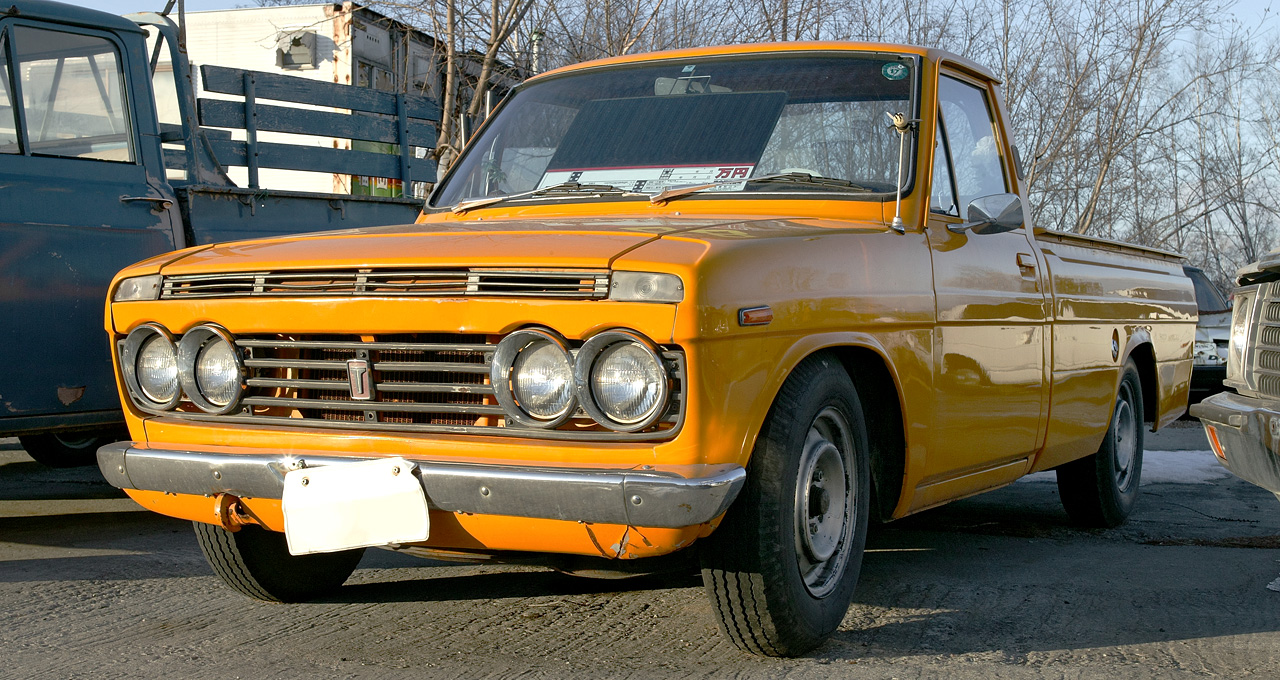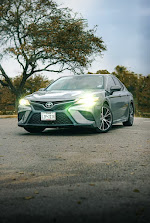The historical backdrop of the Toyota Hilux compasses seven eras, amid which the get has earned a notoriety for being one of the world's most trusted and dependable business vehicles. Having survived amazing situations in that Cold and Antarctic – and all focus in the middle of – the accreditations of this ultra-extreme machine are demonstrated certain. What's more, as Europe's top-of-the-line get it is unmistakably the workhorse of decision for some organizations.
Yet in spite of its straightforward methodology, the Hilux bundle
has slowly created throughout the years to wind up a complete motoring arrangement, conquering any hindrance between work use and ordinary driving needs.
Beginning OF Organization

first generation Toyota Hilux
Actually, the historical backdrop of the Toyota Hilux starts outside of Toyota Engine Organization. Rather, the Hilux discovers its roots in the Briska line of little pick-ups made by Japanese business vehicle maker Hino Engines since 1961. Toyota's history with pick-ups goes back to the SB model of 1947 yet part of the way through the creation of the second-era Briska, Toyota banded together with Hino Engines and pushed forward minor model enhancements.
The Hino Briska was renamed the Toyota Briska in 1967, flagging a refocusing of the Hino brand towards the creation of medium-to-substantial obligation business vehicles.
In the first place Genuine IMPRESSION
It was Walk 1968 when Toyota dealerships in Japan took conveyance of the first real Toyota Hilux gets. This new model bore the N10 body code, and despite the fact that it was brought about by Toyota, the new Hilux kept on being designed and assembled at Hino Engines' Hamura Plant.
Upon its dispatch, the Hilux swelled Toyota's light-obligation get range from a few separate models, the new get joining the current Crown and Masterline (Crown). The last two were auto-based subordinates and Toyota moved quickly to eliminate them in order to portray Toyota's light business vehicle range and its traveler autos.
Yet in spite of its straightforward methodology, the Hilux bundle
has slowly created throughout the years to wind up a complete motoring arrangement, conquering any hindrance between work use and ordinary driving needs.
Beginning OF Organization
first generation Toyota Hilux
Actually, the historical backdrop of the Toyota Hilux starts outside of Toyota Engine Organization. Rather, the Hilux discovers its roots in the Briska line of little pick-ups made by Japanese business vehicle maker Hino Engines since 1961. Toyota's history with pick-ups goes back to the SB model of 1947 yet part of the way through the creation of the second-era Briska, Toyota banded together with Hino Engines and pushed forward minor model enhancements.
The Hino Briska was renamed the Toyota Briska in 1967, flagging a refocusing of the Hino brand towards the creation of medium-to-substantial obligation business vehicles.
In the first place Genuine IMPRESSION
It was Walk 1968 when Toyota dealerships in Japan took conveyance of the first real Toyota Hilux gets. This new model bore the N10 body code, and despite the fact that it was brought about by Toyota, the new Hilux kept on being designed and assembled at Hino Engines' Hamura Plant.
Upon its dispatch, the Hilux swelled Toyota's light-obligation get range from a few separate models, the new get joining the current Crown and Masterline (Crown). The last two were auto-based subordinates and Toyota moved quickly to eliminate them in order to portray Toyota's light business vehicle range and its traveler autos.
second generation Toyota Hilux
The new Hilux – its name a compression of "high" and "extravagance" – used a different casing development with a twofold wishbone/curl spring suspension set up at the front and an inflexible hub/leaf spring plan at the back.
In the beginning, the Toyota Hilux started as a short-wheelbase model controlled by a four-chamber 1.5-liter R-arrangement petrol motor with a segment shift, four-rate manual gearbox driving the back wheels. A little more than a year into creation in April 1969, the Hilux extent was developed (truly) to incorporate a long-wheelbase model. February 1971 saw the landing of a gutsier 1.6-liter form that supplanted the base motor. The traveler limit was for three individuals sitting side by side on a seat.
For the vital North American market, Toyota rolled out some one-of-a-kind improvements. In any case, the Hilux name wasn't utilized – rather, the get was just badged as the 'Toyota' to avert disarray over its name and reason. The American showcase just got bigger 1.9-or 2.0-liter R-arrangement powerplants, and just the short-wheelbase case with its 1.85m since a long time ago bed was offered to purchasers.
Enhanced Extravagance
The second-era Hilux was dispatched in May 1972 for the 1973 model year and denoted the's first experience with the UK market. Basically an adjusted variant of its antecedent, the N20 arrangement highlighted an upgraded body with marginally broadened wheelbases, more agreeable inside, and persistent motor reach.
Additionally enhanced for the second era were Hilux's security highlights – it now had servo-helped double brake expert chambers and stack-detecting brake proportioning valves. Also, not long after dispatch, the North American market saw the presentation of a long-wheelbase model with a 2.25m stacking bed (see examination underneath in the middle of N10 and N20 arrangement load sounds). A segment-mounted four-pace manual gearbox was the standard transmission setup, however, purchasers were currently ready to indicate a story-mounted gearshift, erasing the three-man seat for two individual seats.
third generation toyota hilux
A higher determination model was acquainted with a few markets from 1974 onwards, offering an all the more capable 2.0-liter R-arrangement motor and discretionary three-rate programmed gearbox, the first of its kind ever fitted to the Hilux.
This move upmarket was reflected in the US in 1975 with the presentation of a bigger 2.2-liter engine and SR5 trim assignment, alongside the alternative of a five-pace manual gearbox. In October 1975 the 2.0-liter motor was erased in every single other business sector, merging the Hilux with one 1.6-liter unit to meet new discharge gauges.
ALL ROUND UTILITY
Flexibility was the watchword for the third-era N30 arrangement Hilux when it went at a bargain in September 1978. Despite model – there were presently three standard-length and four long-wheelbase subsidiaries – the third-gen Hilux was intended to offer cantina particular and ride solace. This prompted an advancement of the antecedent's twofold wishbone front suspension that traded the loop springs for a torsion bar.
Altogether, another top-of-the-extent Super Choice model was presented from dispatch; its amplified taxi was 90mm longer than standard, essentially enhancing inside space. The Super Fancy was later supplemented with a full twofold taxi adaptation with four entryways and two columns of seats. All higher-evaluation models got front circle brakes as standard, and purchasers could now determine a Toyota-emblazoned back end. A significant number of these changes were a result of Toyota's watchful investigation of the US market, where the Truck routinely served as a traveler auto and recreation vehicle. Indeed, even the front of the Japanese handout for the Hilux broadcasted that it was "conceived in Japan, brought up in the US".
The new double-reason nature of Hilux was fortified by the initial four-wheel drive model in October 1979, which received the driveline and gearbox exchange case from the 40-arrangement Land Cruiser partnered to a modified adaptation of the now-restored 2.0-liter R-arrangement petrol motor. Diesel power took after with a 2.2-liter L-arrangement motor, accessible without precedent for both back and four-wheel drive groups.
REMODIFICATION
Toyota discharged the fourth-era N40 case Hilux in November 1983, and for some time it was accessible close by its antecedent, which stayed on special in the local business sector as a back-wheel drive base model.
Then again, the more up-to-date era vehicle was instantly described from its more established kin by its alluringly rankled curves and restored inside. What didn't change was its notoriety for close indestructibility; a certainty that was underlined by BBC Top Rigging in its unsuccessful endeavors to "murder" one hard-worked case.
fourth generation toyota hilux
Single and twofold taxi forms were accessible from dispatch, including another raised-bed model with three base pivoted sides. These augmentations expanded the quantity of Hilux varieties from 17 to 20.
Purchasers of back-wheel drive models could look over four motors – 1.6-or 1.8-liter petrol, and 2.2-or 2.4-liter diesel – while four-wheel drive models utilized either a 2.0-liter petrol or the biggest 2.4-liter diesel.
fifth generation toyota hilux
Since the dispatch of the N40, the overall business sector for recreational vehicles had become exponentially, with SUVs like the Portage Horse and Nissan Pathfinder all of a sudden showing up on forecourts.
Toyota responded quickly and with effortlessness by adjusting the short-edge bed of the Hilux, expelling the bulkhead from the back of the taxicab, including a one-piece fiberglass-strengthened plastic overhang, fitting a seat in the back, and softening the back suspension.
Bigger motors were fitted, including 2.4-liter turbo and 3.0-liter V6 petrol motors, however, the bigger measurements of these units required the improvement of a more extensive front track and the change from a strong front pivot to a free setup.
_SR_4-door_utility_(2011-11-30)_01.jpg)
sixth generation toyota hilux
The vehicle that came about because of this unexpected revival was propelled to the world from May 1984 onwards as either the Hilux Surf (local business sector) or 4Runner – basically a three-entryway station wagon with rough terrain capacity like that of the Area Cruiser. Toyota likewise received adjustments from the A-column advances all through the whole Hilux range.
Rethinking THE Idea
September 1988 denoted the presentation of the new fifth-era N50 suspension Hilux, with updated bodywork that spoke to numerous visual and physical enhancements over the active adaptation.
Constructed to the three central ideas of force, solidness, and solace, the new model's inside was significantly more auto-like as far as its hardware level and dashboard outline. Outside, the outside bodywork now included incorporated window bands in the entryways and a one-piece stacking sound that disposed of the stress of rust created in the creases.
At long last, four-wheel drive models got unmistakable curve flares that extended the general body by 40mm, while back-wheel drive models had a smaller style with customary level-sided front wings and raise quarter boards.
The motor range correspondingly separated somewhere around four-and back-wheel drive models; the last either got another 1.8-liter Y-arrangement petrol or 2.4-liter L-arrangement diesel, the previous a gutsier 2.0-liter Y-arrangement or 2.8-liter diesel. Later in the N50's generation, the motor scope of the back-wheel drive models was moved up to coordinate that of the four-wheel drive renditions.
seventh generation toyota hilux
In the interim, the 3.0-liter V6 petrol motor was saved for twofold taxi models and the second-era Surf/4Runner, and in answer to differentiating client needs, the quantity of back-wheel drive models accessible with the four-rate programmed gearbox was expanded.
The second-era Hilux Surf/4Runner landed for the 1990 model year, again based on the Hilux stage; in fact, the models were verging on indistinguishable from the B-column forward. Then again, though the original model had a straightforward FRP structure on top of the get bed, the new auto highlighted a completely incorporated steel body with five entryways (a three-entryway was accessible amid the first 50% of the generation cycle howe
Tags:
Car Talk

Curious about how toyota hilux evolved. You can read this blog and visit honda replacement key which provides you Honda key replacement at affordable price. Very good article.
ReplyDelete